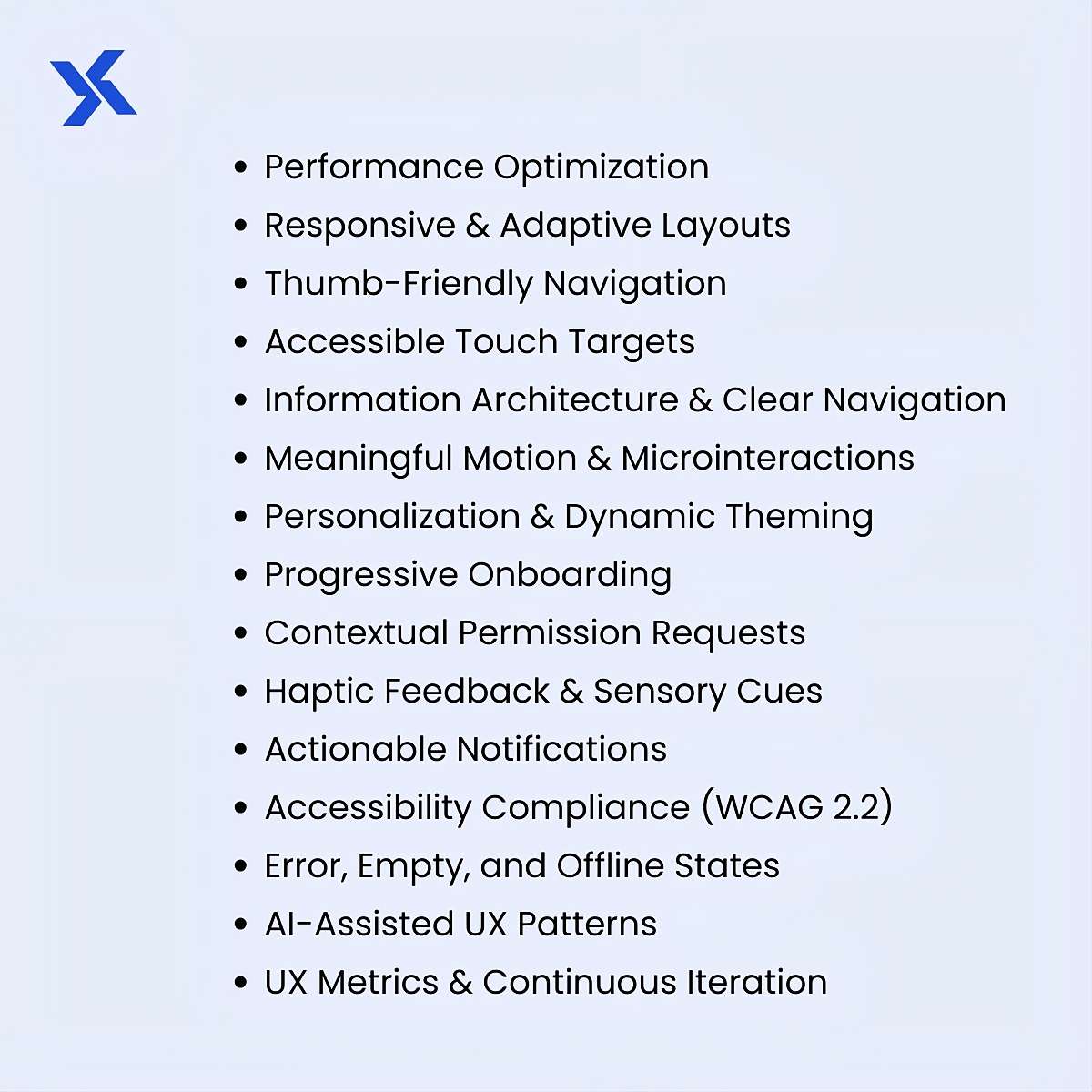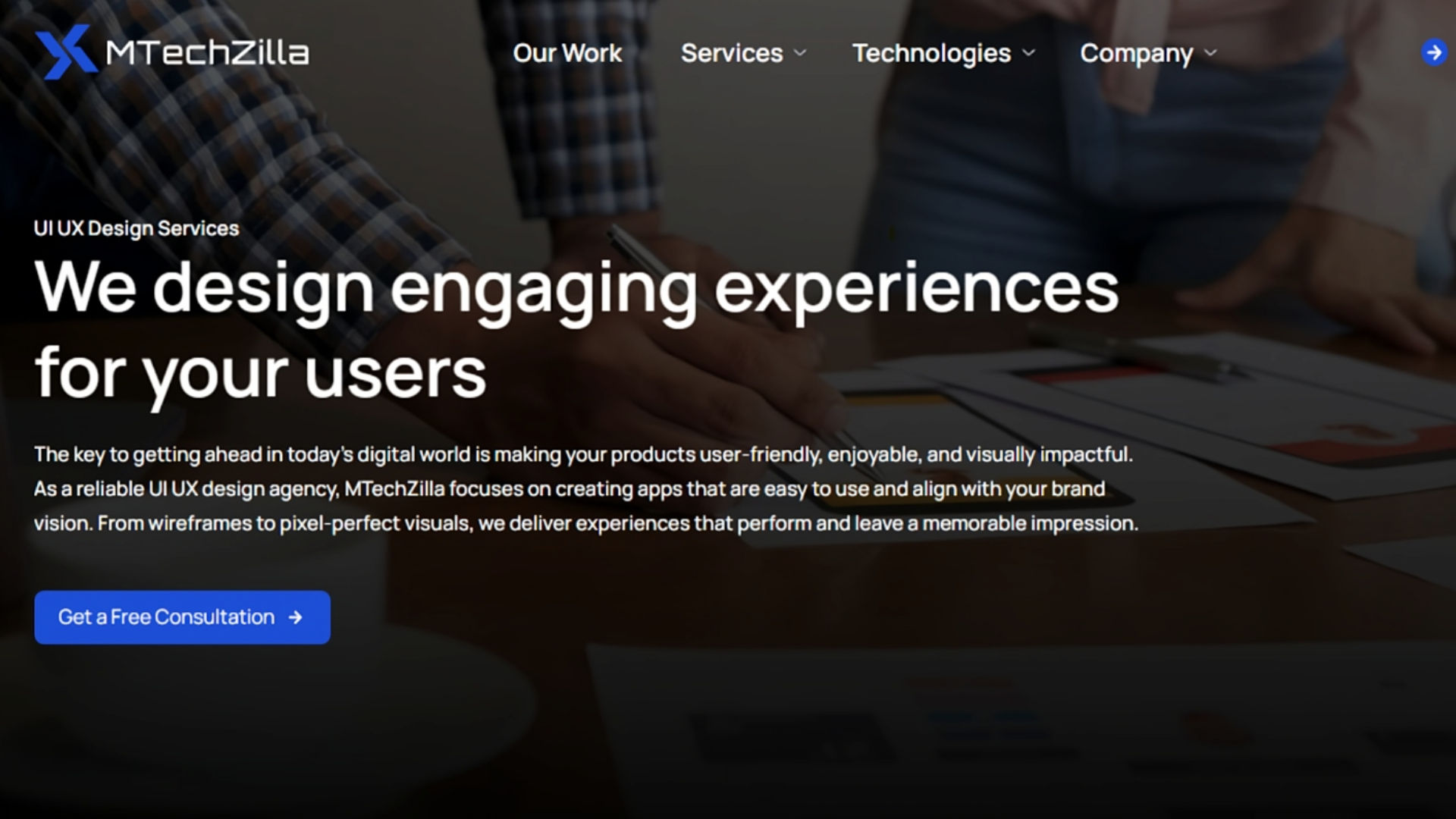August 26, 2025
13 min read

Recent reports on mobile app UX highlight how essential user experience has become.
About 74% of users are more likely to come back to an app if the mobile experience feels smooth and simple.
Nearly 90% of smartphone users say they continue shopping when the in-app journey is seamless.
Research also shows that 94% of first impressions come from design, and 75% of people trust apps that look visually appealing .
These findings make one thing very clear: UX directly impacts whether users stay or leave.
In practice, poor mobile UX is one of the biggest reasons apps fail. Slow loading times, confusing navigation, cluttered screens, or inaccessible interfaces cause users to abandon apps within the first few minutes. Because first impressions matter so much, even a single frustrating experience can lead to uninstalls.
In this guide, we focus on two key areas:
UX Design Tips: Practical strategies that always work, no matter the year.
2025 UX Trends: New methods, tools, and innovations shaping the future of mobile app design.
Lets start.
Introduction
What is Mobile App UX Design?
15 Essential Mobile App UX Design Tips
Mobile App UX Trends to Watch in 2025
Actionable Steps for Better Mobile App UX in 2025
Conclusion
FAQs
Mobile app UX design is the process of planning and optimizing how people interact with an app, covering navigation, accessibility, and engagement.
Core elements of UX design include:
Usability: Keep flows simple; users should reach goals with minimal effort.
Accessibility: Follow WCAG; ensure tap size, contrast, and screen reader support.
Navigation: Clear, logical paths with consistent patterns.
Consistency: Use uniform styles, interactions, and language across the app.
Visual Design: Clean layouts, readable typography, and appealing UI.
Interaction Design: Intuitive gestures, feedback, and animations that guide, not distract.
Performance: Fast load times, smooth transitions, responsive interactions.
User-Centric Approach: Base design on actual user needs, feedback, and behavior.
Whether you’re an entrepreneur, product leader, designer, or developer, staying up to date with mobile app UX best practices and trends is essential. Our next section will focus on this.
Today’s users have zero patience for poor experiences. The moment they open an app, they expect it to load quickly, respond smoothly, and guide them effortlessly toward their goal - whether that’s completing a purchase, booking a ride, or simply checking a notification.
If an app feels slow, confusing, or cluttered, users don’t hesitate to abandon it and switch to a competitor. This is why UX design has become the deciding factor between apps that succeed and those that fail.
So, let’s begin with the top three essential mobile app UX design tips: Performance Optimisation, Responsive & Adaptive Layouts, and Thumb-Friendly Navigation. From there, we will move step by step through all 15 in detail.

A smooth, fast app is the first thing users notice. No matter how appealing your design is, if your app lags or freezes, users lose trust immediately. In fact, most people won’t wait more than a few seconds before abandoning.
How to achieve this:
Use caching and preloading to reduce waiting times.
Add skeleton screens or loaders to keep users engaged while data loads.
Compress images and optimize assets for lighter performance.
Monitor speed KPIs like app launch time and response latency.
With smartphones, tablets, and foldable devices everywhere, your app must adapt to any screen. A poor layout on a bigger device feels broken and unprofessional.
How to achieve this:
Build responsive grids that adjust to different breakpoints.
Test on multiple devices and orientations regularly.
Use adaptive layouts so content expands smoothly on larger screens.
Plan navigation for foldables and dual-screen modes.
Most people scroll and tap with one hand. If your navigation forces users to stretch, they’ll get frustrated or make mistakes.
How to achieve this:
Keep core actions within thumb reach (bottom of the screen).
Use bottom navigation bars or floating action buttons (FAB).
On large screens, switch to side rails or drawers.
Test navigation flows for one-handed comfort.
Small or crowded buttons create friction. Users should be able to tap with confidence every time.
How to achieve this:
Follow standards: 44x44pt (iOS) and 48x48dp (Android).
Increase tap areas with invisible padding if space is tight.
Maintain enough spacing between interactive elements.
Test buttons with real users for comfort and accuracy.
If users can’t find their way, they’ll quit. A clear structure makes your app feel intuitive and easy to use.
How to achieve this:
Limit menus to 3–5 key categories.
Use clear, familiar labels—avoid jargon.
Add breadcrumbs or back buttons to prevent dead ends.
Map flows with user journey testing before launch.
Motion should explain, not distract. Done right, it makes navigation feel natural and actions feel rewarding.
How to achieve this:
Use animations to show screen transitions or hierarchy.
Keep them short (200–300ms) for speed.
Add microinteractions like ripple effects on taps.
Maintain consistency in easing and speed across the app.
Users enjoy apps that adapt to their preferences. Themes, colors, and personalisation make the experience feel more human.
How to achieve this:
Support dark and light modes.
Enable Material You dynamic colors on Android.
Let users choose theme settings instead of forcing defaults.
Personalise content recommendations where relevant.
If onboarding is too long, users leave. People want immediate value, not a tutorial marathon.
How to achieve this:
Show sample data or demo content instantly.
Use tooltips or hints only when needed.
Keep account creation optional until necessary.
Highlight core value in the first session.
Asking for access too early feels intrusive. Users need to understand the benefit before granting permission.
How to achieve this:
Ask for permissions only when relevant (e.g., location when searching nearby).
Provide a clear reason for each request.
Allow users to change permissions later in settings.
Use friendly, human-centered copywriting in prompts.

Feedback reassures users that their action was successful. Without it, interactions feel flat or uncertain.
How to achieve this:
Add subtle vibrations for critical actions (e.g., send, purchase).
Use audio cues sparingly for confirmations.
Avoid excessive feedback that may annoy users.
Stick to system-level haptic patterns for consistency.
Notifications can either re-engage users or push them away if overdone. They should feel useful, not disruptive.
How to achieve this:
Send only relevant and timely alerts.
Add action buttons so users can respond quickly.
Let users customize frequency and type of notifications.
Avoid spamming—prioritise quality over quantity.
Accessibility is not optional—it’s a necessity. It ensures your app can be used by everyone, including people with disabilities.
How to achieve this:
Follow WCAG 2.2 guidelines.
Support screen readers and voice control.
Ensure text resizing and contrast meet accessibility standards.
Test with real assistive tools before release.
Blank or confusing screens frustrate users. Good design uses these moments to guide and reassure.
How to achieve this:
Write helpful error messages with recovery steps.
Use empty states to suggest next actions (e.g., “Add your first task”).
Support offline use by queuing actions for later sync.
Add visual cues or illustrations to reduce frustration.
AI can simplify tasks, but only if it adds value. Poorly applied AI feels intrusive or confusing.
How to achieve this:
Use AI for autofill, smart suggestions, and personalization.
Always explain why a suggestion appears.
Keep users in control with easy opt-outs.
Ensure AI features improve speed, not complexity.
UX is never final. Without measurement, you can’t improve. The best apps evolve continuously.
How to achieve this:
Track task success rates, rage taps, and drop-offs.
Monitor time-to-first-value for new users.
Collect user feedback regularly.
Remove features that add clutter or show low adoption.
The mobile app ecosystem has evolved rapidly over the past year. Today’s users expect experiences that are personalised, accessible, and seamless, and companies are answering with bold design choices and new technologies.
In 2025, the key UX trends to watch include Liquid Glass and Expressive Design, Super Apps and Ecosystem Expansion, AI-Powered and Context-Aware UX, AR and Immersive Interactions, Voice and Gesture Interfaces, Accessibility and Inclusive Design, Sustainable and Ethical UX, and Predictable and Familiar Interfaces.
Let’s explore these trends one by one.
Apple’s Liquid Glass aesthetic and Google’s Material 3 Expressive Design are pushing visual systems toward translucency, depth, and bold personalization.
If your app relies on flat, outdated visuals, it risks looking obsolete. Refreshing your UI with dynamic visuals and expressive color systems can immediately improve first impressions.
Apps are no longer just single-purpose tools. The rise of Super Apps, which integrate shopping, payments, communication, and more, is reshaping how users engage.
Even if you’re not building a Super App, think about integrations, partnerships, or added services that create more value inside your app, reducing the need for users to switch between multiple platforms.
Artificial Intelligence is shaping context-aware interfaces that anticipate user needs. From predictive text to personalized recommendations, users expect apps to save them time.
If your app can reduce effort through automation such as autofill, smart search, or voice-enabled assistance, you’ll gain loyalty. But transparency is key: always show why AI makes a suggestion and give users control.
Augmented Reality (AR) and immersive motion design are becoming mainstream in retail, education, and travel apps. These create engaging, “real-world connected” experiences.
If your app can benefit from AR, such as try-ons in e-commerce or interactive learning, it’s worth exploring. Even without AR, using immersive transitions and motion graphics can keep users engaged longer.
Beyond touch, voice commands and gesture-based navigation are making apps more accessible and hands-free. This is especially important for multitasking users and accessibility use cases.
Consider adding simple voice interactions (e.g., “Search,” “Next”) or gesture shortcuts to make navigation easier and faster.
Accessibility Compliance (WCAG 2.2) is now a baseline requirement, not a “nice-to-have.” Users expect apps to support screen readers, adaptive themes, and biometric authentication.
Design for everyone. Use proper contrast ratios, scalable fonts, and voice support. Accessibility not only expands reach but also improves overall usability.
Digital wellness and sustainable UX design are growing trends. Users want apps that respect their time, reduce energy use, and avoid manipulative patterns.
Avoid over-notifying or trapping users with dark patterns. Instead, design for mindful engagement—features like session reminders, low-power modes, and transparent data usage create long-term trust.
As design evolves, users still value predictability. Overly experimental patterns confuse people, while familiar navigation, icons, and gestures create confidence.
Stick to standard navigation patterns while layering in modern design updates. Familiarity lowers cognitive load and improves retention.
Improving the user experience of your app requires both strategic thinking and practical execution. You need to balance what users want, where they struggle, and how your product team can systematically address those gaps.
Here’s how you can systematically drive user experience improvements in your next or existing app project:
Before adding new features, you need to know what’s not working in your existing app. Analytics and behavior-tracking tools help you identify bottlenecks, drop-offs, and usability issues.
How to do it:
Use tools like PostHog, Google Analytics, or Mixpanel to track user journeys.
Review heatmaps and session replays with UXCam or Hotjar.
Identify where users abandon onboarding, checkout, or key flows.
Data tells you what is happening, but conversations reveal why. User interviews and surveys uncover frustrations, motivations, and unmet needs.
How to do it:
Run quick in-app surveys to capture real-time feedback.
Conduct remote usability tests with small groups of target users.
Observe users completing tasks to spot where they hesitate or fail.
Rather than designing around features, focus on the job users are trying to accomplish. This mindset aligns design decisions with real-life outcomes.
How to do it:
Frame user needs as: “When I [situation], I want to [motivation], so I can [outcome].”
Redesign flows to reduce steps between intent and outcome.
Remove features that don’t directly support the core job.
Prototyping prevents costly mistakes in development by catching usability gaps early. Interactive drafts allow you to validate ideas quickly.
How to do it:
Build clickable prototypes using Figma, Adobe XD, or InVision.
Run usability tests with 5–10 users before writing code.
Iterate quickly—treat prototypes as experiments, not polished designs.
Accessibility benefits everyone, not just people with disabilities. Designing inclusively ensures your app is usable by the widest audience possible.
How to do it:
Add alt text for images and enable screen reader support.
Follow WCAG 2.2 standards for tap targets, contrast, and text size.
Test using built-in tools like VoiceOver (iOS) or Accessibility Scanner (Android).
UX design is never complete. You should measure outcomes after launch and use insights to refine flows over time.
How to do it:
Track metrics like time-to-first-value, task success rate, and retention.
Monitor NPS scores and app store reviews for qualitative insights.
Schedule UX reviews every sprint to fix usability issues regularly.

If you’re building or improving an app, remember that users don’t care about features alone. What truly matters is how those features feel to use.
As a final takeaway:
Focus on the fundamentals such as performance, navigation, and accessibility.
Stay adaptive by embracing new patterns including dynamic theming, AI assistance, and immersive interactions.
Keep learning from your users. Analytics and direct feedback should guide every iteration.
Mobile UX is not a one-time project; it is an ongoing practice of testing, refining, and evolving. If you are planning to build a mobile app, our team can help you from early ideation and strategy through to final deployment—within your budget.
You can book a free consultation with our UX experts or explore our latest case studies to see how we can support you.
Why is Mobile App UX important in 2025?
In 2025, UX is a key differentiator. A well-designed app improves user retention, increases trust, and drives higher conversions. Poor UX, on the other hand, leads to app abandonment within minutes.
What are the top Mobile App UX trends in 2025?
The leading UX trends in 2025 include Liquid Glass and Expressive Design, Super Apps and Ecosystem Expansion, AI-Powered and Context-Aware UX, AR and Immersive Interactions, Voice and Gesture Interfaces, Accessibility and Inclusive Design, Sustainable and Ethical UX, and Predictable and Familiar Interfaces.
How do I improve UX in my mobile app?
To improve UX, start with a UX audit to identify friction points, talk to real users for feedback, design around Jobs To Be Done, prototype and test early, build accessibility from the start, and track UX metrics like retention and task success rate.
How can AI improve mobile app UX?
AI enhances UX by automating tasks such as autofill, smart search, and personalised recommendations. It reduces user effort but should always remain transparent and give users control.
What is progressive onboarding in UX?
Progressive onboarding introduces features step by step, instead of overwhelming users at the start. This method shows value immediately and teaches users in context as they use the app.
How often should UX be tested or updated?
UX should be reviewed continuously. Ideally, conduct usability testing at each major design stage and schedule UX reviews every sprint to address friction points quickly.
How does mobile app UX impact business success?
Good UX directly impacts retention, app ratings, and revenue. Users are more likely to stay, trust, and pay when the experience is smooth and enjoyable, making UX a critical driver of business growth.


Share your product idea and challenges

Discuss possible approaches and solutions

Define a roadmap for your project